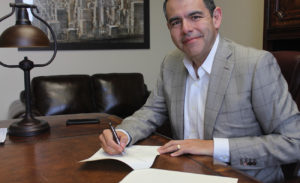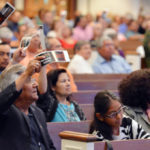No single term—Hispanic, Latino, Latinx or whatever—fully encompasses all the people in the United States who are of Latin American ancestry.

The U.S. government has struggled with terminology for decades, first accepting the label “Hispanic” in the 1970s before shifting to “Latino” by the early 2000s. The gender-neutral term “Latinx” gained currency in higher education about 15 years ago, and some in the younger generation adopted it as their preferred self-identification.
Many different identities fit within the Hispanic or Latino/a box, said Albert Reyes, president and chief executive officer at Buckner International.
Generational differences
A variety of nationalities represent extended families’ countries of origin—including “Tejanos” and “Tejanas” who identify their families as native Texans before Texas was part of the United States, he said. Generational differences and religious backgrounds also factor into self-identification, he added.

“It appears that the closer folks are to their arrival as a first-generation, the more they would identify with their country of origin,” Reyes said. “By contrast, as they become second-, third- and fourth-generation, they would tend to identify more with the U.S.A. and labels that work here.”
Jesse Rincones, executive director of the Hispanic Baptist Convention of Texas, recalled his own experience: “Being a second-generation, born and raised in the Panhandle of Texas, most of my second- and third-gen friends identified more as American.”
While no single term applies to all people of Latin American background, individual preferences typically depend on the particular country where the person or the person’s family originated, said Rolando Aguirre, the president of the Hispanic Baptist Convention of Texas.
Location, location, location
Location also impacts the terms applied to people of Latin American heritage, he added. Mexican-American churches tend to use “Hispanic,” while others use Latino or Latina, especially in Florida, New York, California and North Carolina, he said.
Most people of Latin American ancestry continue to live between two worlds in the United States, since “heritage is more enforced at homes” than in society, Aguirre said.
Sign up for our weekly edition and get all our headlines in your inbox on Thursdays
At home, Hispanics interact more with the culture they left, or the culture their parents left, while outside they are reminded the term that defines them here is “Hispanic,” he said.

In Texas, because of its history and proximity with Mexico, “the Mexican culture has dominated the Latino influence in Texas,” Rincones said. As a result, “the majority of Texans tended to lump all Spanish-speakers or Latinos into the ‘Mexican’ category.”
Because of that, “Latin,” “Latino/a” or “Latinx” may not work as well in Texas as Hispanic would, Reyes added.
“Most communities aren’t large enough to have a Guatemalan Baptist church, Columbian Baptist, Mexican Baptist, etc.,” Rincones said. “So, our Hispanic Baptist congregations that speak Spanish have the privilege—and challenge—of ministering to all those personal Latino identities.”
While Latinos/as tend to distinguish each other’s nationality by the use of Spanish terms and colloquialisms, Rincones said, that would be a difficult differentiation for non-Spanish speakers to make. Food also is a distinguishing characteristic, he added.
Second- and third-generation people in the United States typically identify the least with their family’s native country and are the group that most easily acculturates to non-Hispanic congregations, Rincones added.
‘Tell me your story’
While it is fine for people of non-Hispanic backgrounds to use general terms like “Hispanic” or “Latino/a,” they also must understand those are broad terms, and a greater understanding of a person’s family will lead to a better frame of reference, Reyes explained.
“Those of us that are Hispanic understand that we really do not know each other until we ask about the family history and background,” Reyes said. “We offer grace to each other when using Latino or Hispanic because we know it is an attempt to speak about our collective identity all the while knowing we have distinct backgrounds.”
If individual Hispanics are asked about their histories, then they will be more than willing to share their own stories as well as the stories of their families, he said.
“Tell me your story” may be all the invitation necessary to start a meaningful conversation, as long as a person is willing to take the time to listen, he observed.
“It may always be wise to inquire as to the background or origin to personalize the reference when possible,” Reyes said. “If I am referred to as Latino, I would accept that term but would know the person calling me by that label does not know me.”
Rincones offered similar advice.
“I think a simple and non-offensive way to recognize the culture of a Latino is to ask where their family is from,” he said. “It does take time and relationship to know and appreciate those differences. However, knowing those differences and valuing them can be a great asset to minister effectively to those people groups.”
Certainly, a church’s ministry should focus primarily on Christians’ shared identity in Christ, Aguirre said.
“However, being aware of where we come from and of our heritage will give us a lot of insight in understanding our current context,” Aguirre said. “Our past generations inform our present, which will help us to have a broader perspective of the future.”
Read more articles like this in CommonCall magazine. CommonCall explores issues important to Christians and features inspiring stories about disciples of Jesus living out their faith. An annual subscription is only $24 and comes with two free subscriptions to the Baptist Standard. To subscribe to CommonCall, click here.














We seek to connect God’s story and God’s people around the world. To learn more about God’s story, click here.
Send comments and feedback to Eric Black, our editor. For comments to be published, please specify “letter to the editor.” Maximum length for publication is 300 words.